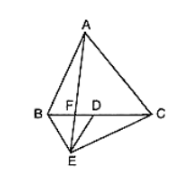In figure ABC and BDE are two equilateral triangles such that D is the midpoint of BC. AE intersects BC in F. Prove that:
(i) ar(ΔBDE) = (1/4) ar(ΔABC)
(ii) ar(ΔBDE) = (1/2) ar(ΔBAE)
(iii) ar(ΔBFE) = ar(ΔAFD)
(iv) ar(ΔABC) = 2 ar(ΔBEC)
(v) ar(ΔFED) = 1/8 ar(ΔAFC)
(vi) ar(ΔBFE) = 2 ar(ΔEFD)

Given that ABC and BDE are two equilateral triangles.
Let AB = BC = CA = x. Then, BD = x/2 = DE = BE
(i) We have,
$\operatorname{ar}(\Delta \mathrm{ABC})=\frac{\sqrt{3}}{4} \mathrm{x}^{2}$ and $\operatorname{ar}(\Delta \mathrm{BDE})=\frac{\sqrt{3}}{4}\left(\frac{\mathrm{X}}{2}\right)^{2}=\frac{1}{4} \times \frac{\sqrt{3}}{4} \mathrm{x}^{2}$
Therefore, ar(ΔBDE) = 1/4 ar(ΔABC).
(ii) It is given that triangles, ABC and BED are equilateral triangles
∠ ACB = ∠DBE = 60°
⇒ BE ∥ AC (Since, Alternative angles are equal)
Trinagles BAF and BEC are on the same base BE and between same parallels BF and AC.
Therefore, ar(ΔBAE) = ar(ΔBEC)
⇒ ar(ΔBAE) = 2ar(ΔBDE) [Since , ED is a median of triangle EBC; ar(ΔBEC) = 2ar(ΔBDE) ]
∴ ar(ΔBDE) = (1/2) ar(ΔBAE)
(iii) Since, triangles ABC and BDE are equilateral triangles
∴ ∠ABC = 60° and ∠BDE = 60°
∠ABC = ∠BDE
⇒ AB ∥ DE (since, alternate angles are equal)
Triangles BED and AED are on the same base ED and between same parallels AB and DE.
Therefore, ar(ΔBED) = ar(ΔAED)
⇒ ar(ΔBED) − ar(ΔEFD) = ar(ΔAED) − ar(ΔEFD)
⇒ ar(ΔBEF) = ar(ΔAFD)
(iv) Since ED is the median of triangle BEC
Therefore, ar(ΔBEC) = 2ar(ΔBDE)
⇒ ar(ΔBEC) = 2 × (1/2) ar(ΔABC) [From 1, ar(ΔBDE) = (1/2) ar(ΔABC)]
⇒ ar(ΔBEC) = (1/2) ar(ΔABC)
⇒ ar(ΔABC) = 2ar(ΔBEC)
(v) ar(ΔAFC) = ar(ΔAFD) + ar(ΔADC)
⇒ ar(ΔBFE) + (1/2) ar(ΔABC) [using part (iii) , and AD is the median of triangle ABC ]
= ar(ΔBFE) + (1/2) × 4ar(ΔBDE) (using part (i))
= ar(ΔBFE) = 2ar(ΔFED) ⋅⋅⋅ (3)
ar(ΔBDE) = ar(ΔBFE) + ar(ΔFED)
⇒ 2ar(ΔFED) + ar(ΔFED)
⇒ 3ar(ΔFED) ⋅⋅⋅⋅ (4)
From 2, 3 and 4 we get,
ar(ΔAFC) = 2ar(ΔFED) + 2 × 3 ar(ΔFED) = 8 ar(ΔFED)
ar(ΔFED) = (1/8) ar(ΔAFC)
(vi) Let h be the height of vertex E, corresponding to the side BD in triangle BDE.
Let H be the height of vertex A, corresponding to the side BC in triangle ABC
From part (i)
ar(ΔBDE) = (1/4) ar(ΔABC)
⇒ (1/2) × BD × h = (1/4) (1/2 × BC × h)
⇒ BD × h = (1/4)(2BD × H)
⇒ h = (1/2) H ⋅⋅⋅ (1)
From part (iii)
ar(ΔBFE) = ar(ΔAFD)
ar(ΔBFE) = (1/2) × FD × H
ar(ΔBFE) = (1/2) × FD × 2h
ar(ΔBFE) = 2((1/2) × FD × h)
ar(ΔBFE) = 2ar(ΔEFD)
Click here to get exam-ready with eSaral
For making your preparation journey smoother of JEE, NEET and Class 8 to 10, grab our app now.
